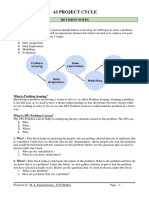0% found this document useful (0 votes)
4 views8 pagesIX Project Cycle & Ethics Notes
The document outlines the AI project cycle, detailing stages such as data acquisition, exploration, modeling, evaluation, and deployment, emphasizing the importance of ethical considerations in AI development. It discusses various data sources, types of machine learning, and the significance of AI ethics, including human rights, bias, privacy, and inclusion. Additionally, it addresses moral concerns related to AI, such as job loss and the black box problem, and provides examples and questions to reinforce understanding of these concepts.
Uploaded by
anaghacomputerCopyright
© © All Rights Reserved
We take content rights seriously. If you suspect this is your content, claim it here.
Available Formats
Download as PDF, TXT or read online on Scribd
0% found this document useful (0 votes)
4 views8 pagesIX Project Cycle & Ethics Notes
The document outlines the AI project cycle, detailing stages such as data acquisition, exploration, modeling, evaluation, and deployment, emphasizing the importance of ethical considerations in AI development. It discusses various data sources, types of machine learning, and the significance of AI ethics, including human rights, bias, privacy, and inclusion. Additionally, it addresses moral concerns related to AI, such as job loss and the black box problem, and provides examples and questions to reinforce understanding of these concepts.
Uploaded by
anaghacomputerCopyright
© © All Rights Reserved
We take content rights seriously. If you suspect this is your content, claim it here.
Available Formats
Download as PDF, TXT or read online on Scribd
/ 8


































































































